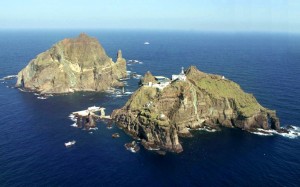[세션2] 발제문: The Media’s Role in the Solution to the Territorial Disputes in Asia
The Media’s Role in the Solution to the Territorial Disputes in Asia
Michael Prieler(Ph.D, Professor at Hallym University)
Ladies and Gentlemen,
It is my great honor to speak here at the 2013 Seminar of the Asia Journalist Association. I would like to thank the Asia Journalist Association and especially Mr. Lee Sang-Ki for inviting me to this seminar.
I was asked to speak, from a Western perspective, about the role Asian media should play in the resolution of territorial disputes in Asia. In other words, I will speak from an outsider’s perspective. I will start this speech with some general observations about only one of the territorial disputes Korea is involved in, even though I am aware that there are several territorial disputes in East Asia at the moment. At the end, I will conclude by speaking about the possible role of the media in the resolution of these disputes.
Let me start this speech with something rather different, and a question to you.
What is this?
 This is a red rose. Or some might say: a red flower.
This is a red rose. Or some might say: a red flower.
My additional question is: Does this rose have any meaning beyond being a flower?
One might say the rose is a symbol of love and romance. The rose as a symbol of love has a long tradition in the Western world. Already the ancient Greeks and Romans identified the rose with the goddess of love. In other words, over the centuries the rose became a cultural symbol for love in many cultures in the West and subsequently in many parts of the world. However, is there anything specific about a rose that looks like love or romance? Is there “love” written on the rose, so that we can read its meaning, or do roses look like, for example, a kissing couple? The answer is: “no”.
The rose has no meaning in itself. The meaning is bestowed on it by the culture.
You might ask now how this connects to our topic. I will argue in the following that it does so very much. We had the rose serving as a symbol of love. So, let me ask you now another question.
What is this?
 It is two small islands in the sea, or one might say, two rocks in the sea.
It is two small islands in the sea, or one might say, two rocks in the sea.
Is there any meaning beyond being islands? Are they a symbol for anything?
Some might say they are a symbol of colonization, a symbol of pride, a symbol of sovereignty.
However, it is the same with these islands as with the rose: these islands have no meaning in themselves. The meaning is given them by culture ? in this case, Korean culture. Other cultures might give totally different meanings to them. For example Japanese culture, or another culture might even give no meaning at all to these islands.
In short, to offer an outsider’s perspective, I was asked for this speech. These are two small islands that have no meaning beyond that for most people outside of Korea. As a result, for most people outside of Korea, it is hard to understand what this whole dispute is all about. The diplomatic fallouts and economic consequences of such disputes have a much higher price than the actual benefits these islands could ever have.
I know a bit about Asian history and that things are not that easy. Nevertheless, I suggest that all involved parties, Koreans as well as Japanese, should drain the emotion from this issue and bring it down to the facts: not historical facts, but the fact that the meaning of these islands is constructed, no matter to whom they belong to. Nobody now derives actual benefit from these islands.
This construction of meaning seem to be rather pervasive in South Korea where schoolchildren are taught throughout their lives that Dokdo is Korean and that there is no doubt about it. The same is said by populist and nationalist politicians and, partly also, by the media. In contrast, in Japan these islands have received relatively little attention and emotions. As one professor at Temple University’s Japan Campus, puts it: “For the Japanese, it’s just a couple of islets without any historical or political significance.” This situation, however, changed recently when the former Korean president Lee Myung-Bak visited the islands. This illustrates the media’s dilemma when it comes to reporting such events, but also the problem that such reports will be used by populist and nationalistic politicians and interest groups.
The media has a dilemma when reporting about such events because the coverage might eventually lead to unintended consequences. The news and images of this visit to Dokdo in the Japanese media were seen by many Japanese as a provocation. Previously, the Japanese public did have much of an opinion about this issue. This visit might become a turning point in the view Japanese have about this issue and might also subsequently lead the Japanese side to a more emotional approach. Newspaper ads were launched to explain about Dokdo/Takeshima and some politicians demanded that schools assume a bigger role in educating children about this topic. This dispute also comes up at a time when Japan has an island dispute with China, which Japanese view much more seriously. In the end, all these disputes seem to be connected with changing power shifts in East Asia. The dispute about the Senkaku Islands (Diaoyu Islands in Chinese) clearly shows what unintended negative effects media reports can have: Demonstrations broke out across China and Japanese businesses were destroyed there. On the other hand, Japanese politicians use the dispute with China (in the same way as Korean politicians use the Dokdo issue) to gain support and popularity and to make Japanese citizens forget about the real problems their country faces.
As can be seen, the media faces problems in contributing to a solution to these disputes. However, we should not deny that the media also can play a positive role by critically analyzing the disputes. It was interesting to see that several Korean media outlets actually questioned and even criticized the visit of former President Lee Myung-Bak to Dokdo/Takeshima. This is an example of an important role the media can play. The media should break down controversies to what they are really all about. They should look beyond the claims of populist and nationalistic politicians and educate the public about the genuine issues and history of disputes. It is also the role of the media to provide the population with an understanding of the other side of the story ? in this case, the Japanese perspective of the conflict; this might lead to better understanding and fewer hot emotions. The media should be careful not to become a mouthpiece for the propaganda of politicians or interest groups.
In summary, I believe that Korea and Japan should move beyond the past and beyond the issue of these islands and look at the bigger picture of peace in East Asia. The role of the media can be to lead the way in this direction. It seems unlikely that either of the two countries will ever give up on the islands, so there seems to be no easy solution to this conflict. It might be a utopian hope, but one solution could be for the two countries to share the two main islands and make them a symbol of peace in East Asia. This solution would gain both countries the respect of the international community and perhaps become a model that other countries could follow when facing similar disputes.
 In the end, I come back to my main point, and I ask you the same question again: What is this?
In the end, I come back to my main point, and I ask you the same question again: What is this?
Yes, it is a picture of two small islands ? and I hope you now all agree with me: two small islands without any meaning beyond being two small islands. Two small islands ? nothing less and nothing more. We should not forget that!





